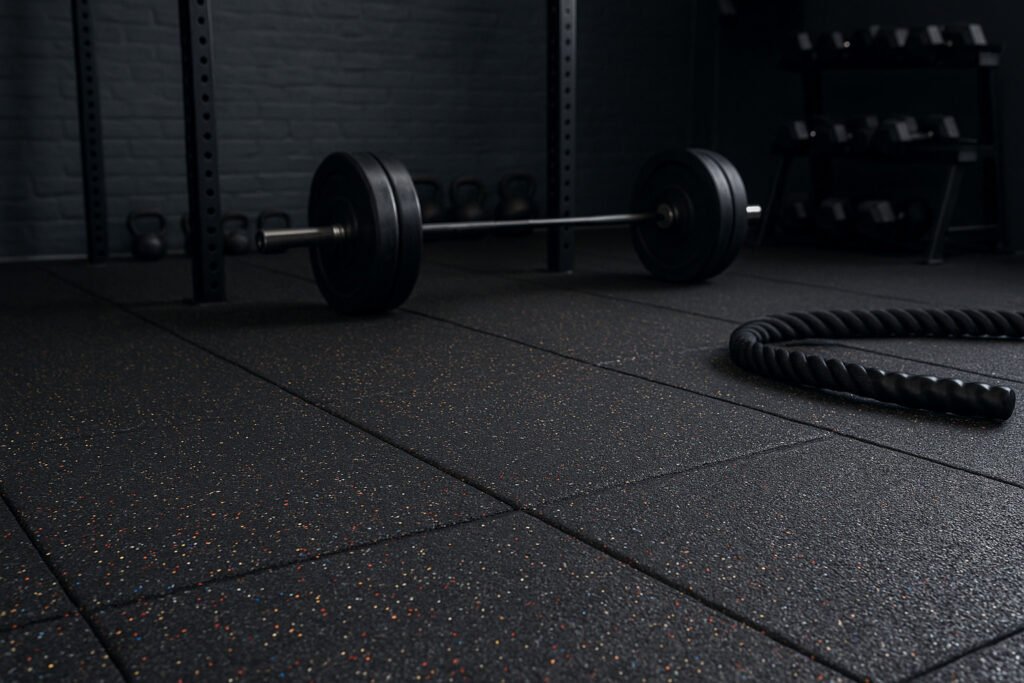What’s the Best Flooring for CrossFit?
Broken tiles. Slippery surfaces. Loud impacts. These are common nightmares in CrossFit gyms—unless you choose the right flooring from the start.
The best flooring for CrossFit is thick rubber tiles made from fine granules or laminated EPDM. They offer shock absorption, slip resistance, and long-term durability for high-impact training.

CrossFit workouts combine Olympic lifts, jumping, running, dragging, and slamming. This intense combination demands flooring that can take a beating without breaking, shifting, or wearing down. After working with CrossFit gyms across Australia, Canada, and Europe, I’ve seen which flooring holds up best—and which fails fast. Here’s everything you need to know.
Why Is Shock Absorption So Important in CrossFit Gyms?
Heavy barbells. Plyo boxes. Kettlebell swings. All of these slam into your floor every day.
High shock-absorbing flooring protects both the athlete and the subfloor, making it a must-have for CrossFit®.
We recommend using tiny granule rubber tiles or composite rubber tiles, available in thicknesses up to 50mm. These materials are dense and heavy, which keeps them stable under pressure and minimizes bounce. They also dampen vibrations and reduce the risk of barbell recoil. Our clients love how they protect the subfloor from cracks and chips.
Learn more on our gym rubber tile page.
Shock Absorption Comparison
| Product Type | Max Thickness | Shock Rating | Best For |
|---|---|---|---|
| Tiny Granule Rubber Tile | 50mm | ★★★★☆ | Olympic lifts, drop zones |
| Composite Rubber Tile | 50mm | ★★★★★ | Full-body functional workouts |
| Puzzle Rubber Tile | 25mm | ★★★☆☆ | Home gyms, moderate training |
What About Installation—Can I Do It Myself?
If you’re opening a new box or just expanding, time is tight. You need flooring that’s fast to install and easy to maintain.
Interlocking rubber tiles can be installed quickly without glue, making them perfect for flexible or modular CrossFit® spaces.
For modular areas, puzzle rubber tiles are a smart option. They don’t need adhesive and can be repositioned if your layout changes. For permanent boxes, we recommend glue-down installation for composite tiles, which have better grip under impact and give a cleaner finish.
Check our project cases to see real-world applications.
Installation Type Comparison
| Tile Type | Glue Required | Installation Time | Removable |
|---|---|---|---|
| Puzzle Tile | ❌ | Fast | ✅ |
| Tiny Granule Tile | ✅ (optional) | Medium | ❌ |
| Composite Tile | ✅ | Medium | ❌ |
Will the Tiles Wear Out from Repeated Impact?
CrossFit isn’t gentle. You need a floor that resists wear from sled pushes, dumbbells, ropes, and sled drags.
Our SBR and EPDM rubber tiles are wear-resistant, anti-slip, and built to last in high-impact environments.
We use high-quality materials that resist cracking, chipping, and wear from friction. Composite tiles have a laminated EPDM surface that adds both strength and aesthetics. They’re also easy to clean and don’t trap chalk or sweat like low-quality tiles do.
Durability Factors to Consider
| Surface Material | Durability | Slip Resistance | Cleaning Ease | Ideal For |
|---|---|---|---|---|
| 100% SBR | ★★★★☆ | ★★★★☆ | ★★★★☆ | Budget or heavy-use zones |
| EPDM Surface | ★★★★★ | ★★★★★ | ★★★★★ | Premium performance gyms |
More product info available on the Lanhefloor homepage.
What Thickness Is Best for CrossFit®?
Going too thin can crack your subfloor. Going too thick can waste budget. So where’s the sweet spot?
The ideal flooring thickness for CrossFit® is 20mm to 30mm for most training zones, and 40mm+ for dedicated lifting platforms.
Most gyms opt for 25mm tiles across the board and use 40–50mm tiles under squat racks or drop zones. We manufacture rubber flooring in thicknesses from 15mm to 50mm to suit your budget and application. Don’t forget: rubber rolls are not suitable for high-impact areas but work great in warm-up or mobility zones.
CrossFit Flooring Thickness Guide
| Area | Recommended Thickness | Product Type |
|---|---|---|
| Olympic lifting zones | 40–50mm | Composite or Granule Rubber Tile |
| General CrossFit WOD | 20–30mm | Any Rubber Tile |
| Warm-up / mobility zone | 6–12mm | Rubber Roll |
Can It Handle Outdoor Workouts Too?
If you’re running a CrossFit® bootcamp outside or expanding to a patio zone, standard gym flooring won’t cut it.
For outdoor workouts, use EPDM or SBR-based tiles designed for weather and UV resistance.
Our outdoor rubber flooring uses UV-resistant surfaces and non-slip materials ideal for outdoor rigs or bootcamp circuits. We also offer EPDM granules for poured-in-place training areas in parks or rooftops.
✅ Conclusion
The best flooring for CrossFit® is thick, shock-absorbing rubber tile—especially composite and tiny granule tiles. Choose based on your workout zones and durability needs.
Explore all CrossFit-friendly flooring options at Lanhefloor.com
Related Articles:
